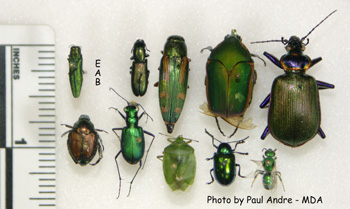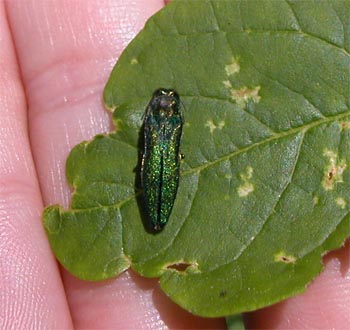Kentucky Emerald Ash Borer (EAB): Resources & Updates
National EAB Resources
Kentucky EAB Resources
- EAB Timeline for KY (PDF)
- Number of Ash Stems by County (PDF)
- 2010 Ky Forest Inventory and Analysis Factsheet (PDF)
- Rules for Shipping and Receiving Ash Wood Products (PDF)
- Ky EAB Compliance Agreement Application Form (PDF)
- Wood Sterilization Options (PDF)
- Ky State Park Firewood Limits (PDF)
EAB Control Information
- EAB Decision Guide (Purdue Extension PDF)
- 2014 Insectide Options for Protecting Ash Trees (PDF)
- EAB Management Statement (PDF)
Identification and Factsheets
- CSI: Your Ash Trees (PDF)
- Green Ash Tree I.D.
- White Ash Tree I.D.
- Blue Ash Tree I.D.
- EAB Field Guide
- Q&A for Homeowners
New Host for EAB
On October 14, 2014, the USDA Systematic Entomology Laboratory (SEL) at the Smithsonian confirmed the partial adult and larval specimens recovered from a white fringetree (Chionanthus virginicus) as emerald ash borer (EAB) (Agrilus planipennis). EAB larvae and a partial adult specimen were collected from four white fringetrees up to 20 miles distant from one another in the Dayton, OH area. Also present in the infested material were D-shaped exit holes and fully developed galleries identical to those caused by EAB. Follow this link for the text of the release.
Emerald Ash Borer Outlook
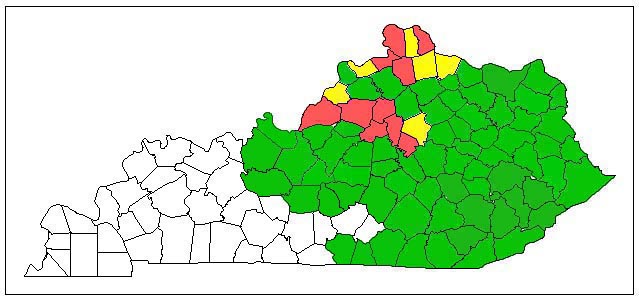
Since its discovery in 2009, the emerald ash borer (EAB) has spread dramatically (Figure 1) within the Commonwealth. Green identifies the counties where EAB infestations have been found. EAB is not necessarily is present throughout these counties at this time. Estimated infestation levels for 2014 made in January 2015 by UK Cooperative Extension Agents are: high = red, moderate = yellow, and light = green. This spread will continue through short-range dispersal flights of the insect and long distance transport of infested wood, primarily firewood. Naturally, those in EAB-infested areas wonder how long they should apply preventive treatments to protect valuable ash trees. At this point, the threat in infested counties remains high and protection should continue.
2017 EAB Detections - Clinton, Cumberland, Green, Taylor, and Wayne counties. (A. Nielsen, KDF)
Management Strategies - 2017
The consensus of EAB researchers in states that have had infestations longer than Kentucky suggests that treatments may be needed for 5 to 7 years after the population peak. Some Kentucky counties are probably near their peak, but it is difficult to know for sure. Beetles will continue to emerge from infested trees and disperse to find surviving ash trees, although numbers of both diminish over time. Variables in the equation include the number of stems in the county and those in landscapes. Information on the numbers of ash stems per county (pre-EAB) is available here. Numbers range from 6.8 million (Henry County) to 38,000 in Martin County. Ash trees in wooded areas will provide sources of beetles until the population crashes from an unsustainable number of host trees.
The most conservative protection strategy at this time is to continue one of the recommended treatment alternatives for 4 to 6 more years. These include:
- An annual soil drench of imidacloprid (Merit, Xytect, etc.),
- An annual trunk spray of dinetofuran (Safari, Trantect), or
- Alternate year injections of emamectin benzoate (Tree-age).
These can be adjusted if a more accurate assessment of the local EAB situation becomes available.
There are no EAB assessment tools, such as an efficient beetle trap, to monitor populations. Any reduction in an existing control program must be made by trial and error. The main alternatives would be to reduce the treatment rates (drench or trunk spray) or extend the treatment interval (trunk injection) to once every 3 years. Full treatment could be resumed if evidence of crown dieback or woodpecker activity point to EAB activity.
EAB Discovery Trail - 2017
The emerald ash borer (or EAB), a native of Asia, is a half inch long dark metallic green beetle. The insect kills ash trees within three to five years after they become infested. Follow the EAB Discovery Trail at Raven Run Nature Sanctuary in Lexington KY, USA, to learn about this invader and the research project developed to slow down EAB impact and save ash trees. This trail was organized by the Forest Entomology Laboratory, Department of Entomology, University of Kentucky.
Points to Consider
- The greatest potential for infestation occurs in the counties pictured red and yellow (map above); counties colored green have a higher risk potentaila than those in white. Homeowners living within red, yellow, or green counties, or within 15 miles of known infestations, who wish to protect their ash trees should start or continue to apply protective treatments. You can get information on effective control options for the EAB from your local Cooperative Extension Office. At this point, it is not clear how long ash trees must be protected while the wave of EAB infestation passes through but 7 to 10 years is a reasonable estimate. This decision guide can help in assessing your situation.
Homeowners can protect desirable ash trees with diameters of 20 inches or less at 4.5 feet above ground level (DBH) using a soil drench containing the active ingredient imidacloprid. Tree care professionals have products and techniques that can protect larger trees or that provide a longer period of protection. This thorough publication covers the insecticide options that are available.
There is no advantage to begin preventive treatments for those living in counties shown in white until an active EAB infestation is found nearby. Unnecessary treatments are not wise expenditures, either on a monetary or ecological basis.
- Buy firewood where you burn it. Moving infested ash, especially as firewood, can lead to more rapid spread of this insect. >EAB adults are capable of flying 1/2 mile or more per day but most spread from newly established sites seems to cover distances in the range of 100 yards. Long distance spread is the result of inadvertent spread by humans in infested firewood and unprocessed ash logs. We don’t want to be our own worst enemy.
- The purple traps once used extensively across the state to survey for EAB will either be out in very limited numbers, or not at all. While the traps had limited effectiveness, they were at least a means of trying to identify new infestations. This leaves detection to extension agents, certified arborists and turf and landscape manager. Report suspected infestations to the Office of the State Entomologist or your local Cooperative Extension Office (859) 257-5838 for confirmation. New findings will be posted on this web page. Continued watchfulness by all will be necessary to limit the spread of this important invasive insect.
Ash Distribution in Ky
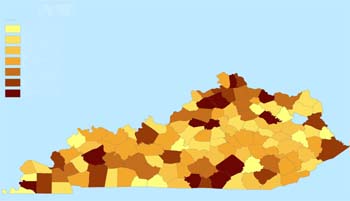
According to the Ky Division of Forestry, there are 130.9 million stems of white ash and 92.5 million stems of green ash in the Commonwealth. This USDA Forest Service Forest Inventory and Analysis map (above) shows the distribution of ash stems by county (darkest color = highest to lightest = lowest) based on a 2006 Forest Inventory and Analysis.The top five counties are Henry, Bath, Spencer, Pulaski, and Hopkins. All have more than 6 million. Numbers of ash stems per county are available under the Ky EAB Resources list above.
Identifying the EAB
EAB adults are 3/8 to 1/2-inch long and very narrow (about 1/5-inch wide). The head is blunt, the body tapers noticeably at the end of the abdomen. The wing covers are emerald green; the top of the abdomen, visible when the wings are spread, is metallic purple-red.
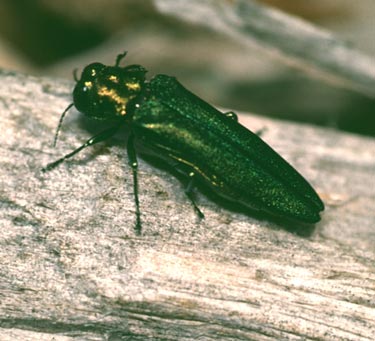
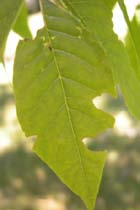 Newly emerged adults are most active when it is warm and sunny. They feed for several days before mating, chewing irregular notches along leaf margins. Mated females will feed for another week or two before laying eggs in bark crevices or under bark flaps on the trunk. One female will lay between 60 and 90 eggs.
Newly emerged adults are most active when it is warm and sunny. They feed for several days before mating, chewing irregular notches along leaf margins. Mated females will feed for another week or two before laying eggs in bark crevices or under bark flaps on the trunk. One female will lay between 60 and 90 eggs.
Many green insects can be confused with the emerald ash borer. The picture below (courtesy of the Missouri Dept Agriculture) shows an EAB along with several look-alikes. The line-up includes (top row L-R): EAB, a bark gnawing beetle (family Trogossitidae), Buprestis rufipes, green June beetle, and the caterpillar hunter. (bottom row L-R) Japanese beetle, a green tiger beetle, green stinkbug, dogbane beetle, and a metallic bee. The picture shows relative sizes and shapes of these insects.
